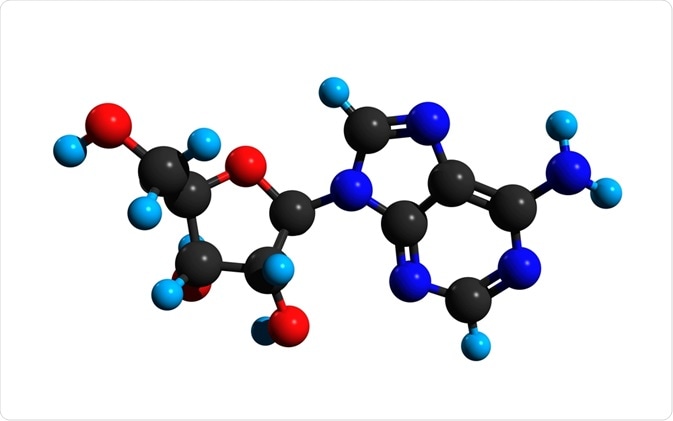Adenosine kinase is an important enzyme that regulates both the intracellular and extracellular concentrations of adenosine. The inhibition of this enzyme has numerous clinical applications ranging from analgesics to anti-seizure therapies.
 Adenosine Kinase?" />
Adenosine Kinase?" />
Image Credit: Linnas/Shutterstock.com
What is adenosine?
Adenosine is an endogenous purine nucleoside base that is most commonly associated with the energy-carrying molecule adenosine triphosphate (ATP). As a primary component of ATP and other energy metabolites, adenosine is often referred to as a ‘retaliatory metabolite,’ since any drop-in energy supplies cause adenosine levels to rise and negative feedback inhibition to occur to conserve energy and reduce metabolic demand.
Adenosine is also a key component of several important coenzymes, such as nicotinamide adenine dinucleotide (NAD) and flavin adenine dinucleotide (FAD). Taken together, adenosine plays an important role in controlling various physiologic functions including blood supply levels, glucose homeostasis, and lipolysis.
In addition to its participation in ATP-related pathways, adenosine is also found in both the intra- and extracellular spaces of cells throughout the body. Although the concentration of adenosine within the interstitial fluids is typically low under normal conditions, the levels of this nucleoside will significantly increase when tissues are injured as a result of inflammation, cancer, hypoxia or ischemia.
This rise in adenosine levels will cause adenosine receptors, namely A1, A2A, A2B, and A3, to activate different cellular responses to restore tissue homeostasis.
What is adenosine kinase?
Adenosine kinase (ADK) is the primary enzyme involved in the natural clearance of adenosine by regulating the concentrations of this nucleoside within both the intracellular and extracellular spaces of the cell.
Moreover, ADK is an evolutionary ancient and highly conserved phosphotransferase enzyme that converts adenosine into 5’-adenosine-monophosphate (AMP).
During this reaction, ATP is used as the primary phosphate donor when magnesium is present. Whereas one of the two catalytic sites of ADK is responsible for this reaction, a second site is reserved for ATP and adenosine diphosphate (ADO).
ADK is unique in the fact that its levels are regulated by its substrates and products, as well as other factors that provide information to ADK molecules on the current energy state and health of the cell.
Within the human placenta, for example, adenosine levels exceeding 2.5 µM, accompanied by ATP and magnesium levels around 0l;2 mM, will result in the inhibition of ADK.
Similar substrate inhibition occurs in human erythrocytes and is also dependent upon pH and magnesium levels within these cells.
Therapeutic role of ADK
Adenosine has an extremely short half-life of fewer than 10 seconds, thereby eliminating any potential therapeutic application of this nucleoside.
Therefore, several different pharmacological approaches have been developed to increase adenosine levels in the body to promote the activation of adenosine receptors.
The main two agents that have been developed to augment the activities of adenosine include adenosine receptor agonists and ADK inhibitors.
As compared to adenosine receptor agonists, which are associated with high selectivity capabilities, ADK inhibitors can potentiate the endogenous stress response of the body, thereby promoting the site- and event-specific actions of endogenous adenosine.
As a result, ADK inhibitors can affect a wide range of complex networks that rely on an increase in adenosine tissue concentrations, which cannot occur when receptor-specific ligands are used.
Applications of ADK inhibitors
The dysfunction of ADK is associated with several different pathologies including, but not limited to, diabetes, cancer, and epilepsy. In addition to mitigating these diseases, ADK inhibitors are also used to regulate adenosine levels in several different health conditions.
To improve the specificity of these drugs, various localized and focal therapeutic approaches to ADK inhibitors have also been developed, which include the transplantation of stem cells with ADK deletions and the use of gene therapy vectors to reduce ADK expression in vivo.
Neurological disorders
Within the brain, adenosine is an important regulator of neuronal excitability. As a result, any dysregulation in ADK levels can alter adenosine homeostasis, thereby contributing to a wide range of neurological and neuropsychiatric pathologies, which can include epilepsy, schizophrenia, altered sleep patterns, stroke, traumatic brain injury, and hearing loss.
In some cases of epilepsy, the root cause is overexpression of ADK within the astrocytes, which leads to a deficiency of adenosine that inhibits neuronal excitation and ultimately leads to the generation of a seizure.
The incorporation of ADK inhibitors in the treatment of patients with this type of epilepsy pathology can, therefore, lead to a significant reduction in the occurrence of their seizures.

Image Credit: Kateryna Kon/Shutterstock.com
Pain management
The origination of various types of pathologic pain, particularly neuropathic pain, has been found to share common mechanisms with epilepsy; thereby limiting the usefulness of common analgesics.
For that reason, ADK inhibitors have become increasingly used in the treatment of different pain states.
While several animal models of nociception have shown promising results, the poor bioavailability, short half-life, and limited pharmacological selectivity have stopped further preclinical testing of these inhibitors for pain management.
Renal disorders
In diabetes Mellitus, ADK levels can be decreased by up to 50% in several different critical tissues including the kidney, heart, and liver.
Reduced ADK expression in these tissues has been associated with the suppressed proliferation of diabetic T lymphocytes and excessive stimulation of A2A receptors.
The rise in adenosine signaling in the diabetic brain has been associated with the development of diabetic encephalopathy. Therefore, the restoration of ADK levels
Sources
- “What is Adenosine?”
- Morandi, F., Horenstein, A. L., Rizzo, R., & Malavasi, F. (2018). The Role of Extracellular Adenosine Generation in the Development of Autoimmune Diseases. Mediators of Inflammation. doi:10.1155/2018/7019398.
- Boison, D. (2013). Adenosine Kinase: Exploitation for Therapeutic Gain. Pharmacological Reviews 65; 906-943. doi:10.1124/pr.112.006361.
- Kose, M., Schiedel, A. C., Bauer, A. A., Poschenrieder, H., et al. (2016). Focused screening to identify new adenosine kinase inhibitors. Bioorganic & Medicinal Chemistry 24(21); 5127-5133. doi:10.1016/j.bmc.2016.08.026.
- Cao, W., Wan, H., Wu, L., An, X., et al. (2020). Adenosine kinase inhibition attenuates ischemia reperfusion-induced acute kidney injury. Life Sciences 256. doi:10.1016/j.lfs.2020.117972.